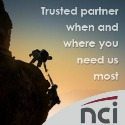
In the first half of the 20th century, organizing and disseminating large amounts of information was relegated to the world of librarians and academics. But on this side of the Information Age, the term big data is part of the everyday vernacular in the business world, no matter what industry you’re in.
WashingtonExec recently spoke with David Simon, Head of Sales and Offering General Manager at CSC, about the role of big data in government and why the challenge of big data is really a big opportunity for those contractors willing to step up.
Structuring a Mountain of Data
From the hundreds of tweets happening each minute to the numerous cameras capturing images at every turn, 30 billion pieces of content are being processed each day. “There are ten billion devices connected to the Internet, significantly more devices that there are people on Earth,” said Simon. “Some of my industry peers are predicting there will be 50 billion devices connected to the Internet by 2020 and that a third of all data will pass through the cloud.”
Thanks to the explosion of social media, most of the data we generate is unstructured.
“Data in its raw form proves to be a challenge for organizations to manage,” said Simon. “Data scientists and analysts are working with terabytes of data – we’re no longer in the kilobytes or megabytes.”
This mountain of data is often derived from five or more disparate sources, making it even more challenging to wrangle. “Each individual data set that’s coming in might be formatted differently, so you’re dealing with different types of data that contain different particular data points, resulting in massive amounts of unstructured data,” said Simon.
However, there is tremendous value in this seemingly random data, once it has been properly sorted and analyzed. “For the last two years at CSC, my whole focus has been developing solutions aimed at creating tools that allow analysts to freely explore data using our solutions that enable the processing and analysis of unstructured data,” said Simon. “However, we also recognize the talent that has worked with the SQL approach for some time now. Part of how we’re handling the structured and unstructured data layers is through abstracting SQL and NoSQL as well as the ease of use with API’s to allow the discovery of both structured and unstructured data.”
At the end of the day, the best approach to big data is two-fold. “It’s not looking at whether it’s a structured or unstructured data problem, but asking how are we able to perform analytics across both environments,” said Simon.
“Exploitation of both public and private clouds creates synergies between the technologies that enable an organization to gain efficiencies and insights about their data,” he continued. “Because the data is generally not neatly formatted, our numbers indicate that data scientists spend 80 percent of their time cleansing and prepping the data before they ever get a chance to do the analytics.”
Saving time in this area helps to save money and improve efficiency. “Several of my customers are only looking at 30 days’ worth of data and then they’re dumping it,” explained Simon. “When I show them solutions that enable them to look at larger data sets over longer periods of time, they immediately start to see trends in their data that enable them to make better business decisions. Ultimately, it’s not a question of structured or unstructured, it’s how do you get the ability to synthesize both and look at large data sets that have a variety of data contained within them.”
As with anything that seems large and unwieldy at first glance, it’s best not to bite off more than you can chew with big data. Focusing on specific requirements seems to be the way to go.
“The most successful companies out there are tackling a specific area or requirement in the life cycle and tailoring their solutions to address the need,” said Simon. “Too many companies are making the mistake of trying to address and solve all of the big data problems. The reality is the most successful companies are the ones that are going to their customers and identifying what their requirements and needs are in the big data space, and focusing on a particular part of the life cycle process.”
Simon uses the Department of Defense as an example:
“A lot of their big data projects take aim at making the best use of unmanned aerial vehicles (UAVs) and how to leverage that. Some big data projects are focused on analyzing files while other projects are aimed at using the UAVs more efficiently for collection. And other UAV projects around big data are looking at fuel efficiency and how we increase time on station. The companies that go to their customer and listen to what their real requirements are and focus on one part of the problem are the ones who can deliver results because they aren’t trying to focus on too many things at once.”
Besides bringing big data challenges into focus, Simon looks to speed as the next advantage in the industry. “Big data is not new, everybody knows that,” he said. “We’ve been tackling the big data problem for two decades or more. Part of what will be a game changer for many organizations in the federal government and in the private sector is going to not just be big data but how fast it happens.”
“I call it fast data now. If I’m solving a problem, it’s really about how fast I can turn that data.”
Big Data as Opportunity
Even though the contracting industry must keep federal spending cuts in mind when planning business strategies, Simon still sees tremendous opportunity in big data. As Simon sees it, true innovation is always in demand. “The federal government will continue to demand cost-effective forms of innovation for information processing and as a result, they’re looking to gain greater insights to facilitate better decision-making,” he said. “The only way they can facilitate better decision-making and begin to move forward in finding those cost savings is by leveraging big data.”
“I think companies within the industry that are driving toward solutions will always capture federal dollars regardless of cuts in spending.”
We asked Simon specifically how big data is intrinsically linked to government. “Keep in mind that big data is also a movement,” he said. “It’s equally about data management and governance, which will always be a part of all government initiatives. How do we properly consolidate infrastructure, properly build out multi-tenet models and design business processes around the ingestion, the storage, the dissemination and even visualization of data? That requirement is not going away, so as a result big data is a huge opportunity. If you implement big data solutions correctly, it eliminates costs for the government, it will get rid of bloated development teams, and it will decrease cost and provide value to the government at a faster rate.”
A common perception of government IT is that the public sector is always trying to catch up to private sector innovation. However, when it comes to big data, commercial industries are looking to the government and contracting communities to pave the way.
“The Intel community continues to be the leader around technologies and capabilities of big data because of the sheer volume and amount of time invested in this area,” said Simon. “I’m seeing demands by manufacturing, banking and retail for all types of solutions that were birthed and matured by organizations supporting federal clients. For one of the first times in my career, I see commercial looking to the federal government, and to the industry supporting the federal government, for big data solutions to bring those best practices of government to the private sector.”
In fact, the commercial and government sectors have refined big data specialties that can – and should – complement each other in practice. While the commercial sector focused on decreasing cost of scale in the early years, the government sector was more concerned about security. Now, they can learn from each other.
“The commercial market is just now starting to understand and insert the security, while the government is looking at cost to scale, so they’ve actually approached the big data from two different perspectives,” said Simon. “As a result, there will be lessons learned and shared across public sector to private industry.”

The Internet of Things (IOT) is another area where Simon sees opportunity for the big data industry. “”It was thirty years ago when the kids at Carnegie Mellon connected the first Coke machine to the Internet,” he said. “IOT is where things are going and God bless the dreamers, it’s what makes this country great. Today we see the maturity of a vision that was birthed three decades ago.”
If social media accelerated the big data movement, just wait and see what effect IOT will have on the industry. “The environment today is made up of millions of censors and devices that generate non-stop streams of data. This is a big data guys dream come true,” said Simon. “Analytics around a growing network of everyday objects, from industrial machines to consumer goods, it doesn’t get any more exciting than that.”
“The fact that they can share information and complete tasks while I’m still eating breakfast, it’s a virtual promised land if industry and government work together to achieve great things.”
Simon sees great things in store at the convergence of IOT and big data. “This is where I come back to fast data – IOT truly takes big data and makes it fast data,” he said. “It’s the perfect storm around machine learning, around mobility as well as analytics, with a strong cloud architecture, neatly secured with a big-old cyber bow on top.”
Unplugging Still Matters
From social media to our many devices, the more connected everything becomes, the more important it can be to disconnect from the busyness of everyday life. For Simon, taking that much-needed break involves literally unplugging his smartphone and tablet.
“I like to get out into nature, I like to be anywhere outside, it gives me a chance to unwind and relax,” he said. “I think executives, particularly in the DC community, don’t disconnect enough and create white space. However, the only way we can be innovative and maintain high energy and be passionate about our causes and our customers is to unplug. If you’re not unplugging one day every two weeks and going without your device, I just don’t think you’re investing in yourself enough. I’m tired of walking into meetings and people putting their device on the table. Leave your device at your desk, leave it in your pocket, and turn it off. So what’s my hobby, what’s my relaxation? I love just having a great conversation in a community where there isn’t a device sitting on the table.”


